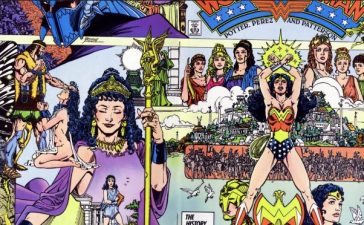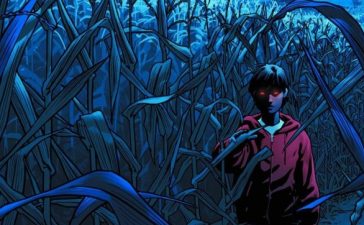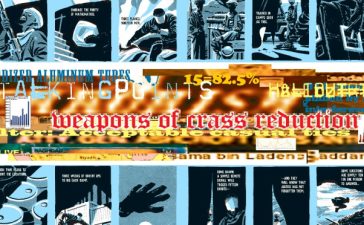
During the month of September DC Comics will be doing a line wide crossover event affecting almost all of their superhero titles. If you’d like to skip this event but still need your DC fix NBC has you covered with DC’s Post Crisis Rebirth. In it we will explore the many important, influential and just plain rad titles that came out of DC Comics original line wide reboot. Our first entry will focus on Mark Waid’s Flash Arc The Return of Barry Allen.
When looking at DC Comics from the post Crisis era it’s impossible to not see their influence plastered across the medium today in multiple ways. The Frank Miller Year One/Dark Knight Rises/Alan Moore Watchmen/Swamp Thing influence is omnipresent almost everywhere you look while Morrison’s and Gaiman’s cerebral qualities to Doom Patrol/Animal Man/Sandman is the inception point for modern surrealism in comics. But what’s probably as influential if not more so is the everyman hero style that’s become a staple of modernizing superhero’s for the late 20th and early 21st century. Everyman superhero writing is essentially a way to write superhero’s that makes them relatable to the reader by using an internal dialouge that is meant to read like a casual conversation you’d have with a friend similar to JD Salinger’s influential Catcher In The Rye. This has become a hallmark of modern DC Comic and it has been for quite some time as you can see it in the best and most influential work of writers like Geoff Johns, James Robinson, Greg Rucka and Jeff Loeb while new kids on the block like Scott Snyder, Jeff Lemire, Greg Pak, Charles Soule Kyle Higgins and James Tynion IV have all utilized that narrative style for a lot of their most signifigant comic work at the publisher. Heck notable marvel writers like Matt Fraction, Kelly Sue DeConick, Rick Remender and Ales Kot all play with that writing style as well and even legend in his own right Ed Brubaker adopted it for his first DC work on Batman before developing his own narration style that we would see later on and thats in spite of being mentored by the Hernadez brothers. When I look back at the eptimology of this style, while you can clearly see the influence of pre crisis writing from Frank Miller and Alan Moore on the technique, it all really comes together on Mark Waid’s brilliant Flash run post Crisis Of Infinite Earths and the way he utilizes that as a conversation with both the readers and his predecessors on The Return Of Barry Allen arc is where that style truly comes into it’s own. So while Watchmen, The Dark Knight Returns, Year One, Doom Patrol, Sandman, Swamp Thing and Animal Man have all had a very clear and large influence on the way modern superhero comics are written Waid’s run on the Flash is at least as important as those above mentioned comics if not possibly more so in terms of it’s breath and scope of influence on modern comics.
In terms of Post Crisis comics The Return Of Barry Allen was published about six years after the event but it is so tied into Crisis Of Infinite Earths that it’s impossible not to consider both comics with one another. Waid himself was an editor for many of the best post crisis comics as he came from Fantagraphics to oversee the such influential post Crisis comics like Doom Patrol, Action Comics, Legion Of Superheros and Wonder Woman before becoming a freelance comics writer of his own. He took over a Flash title in flux as the Flash of the pre crisis DC known as Barry Allen had sacrificed his life to save the universe in Crisis Of Infinite Earth only to be replaced by his former side kick/Kid Flash Wally West in the main line of titles. One of the fun parts about DC Comics is how their just below the headline group of hero’s like your Flash or Green Lanterns have always been replaced by new versions of the same hero and the legacy that those different versions have created within the comics history. This is especially apparent for The Flash who was one of the first to see have that replacement with Barry Allen taking over for the original Jay Garrick. Your favorite Flash says as much about you as it does the quality of the comics. I’m partial to Wally West for a number or reasons chiefly him being the Flash for some of my favorite comics in general including Waid’s Flash run in addition to Morrison and Waid’s JLA or Wolfman/Perez New Teen Titans as well as relating to him on a personal level where Wally comes from a metropolis in the Midwest called the Twin Cities like myself and is in a interracial marriage like I am now. That’s what makes him an interesting parallel for real life as he comes from a more traditional legacy of hero’s but also has his own very modern elements that reflects a lot of what I’ve experienced having grown up in the Midwest in the 90’s/2000’s where tradition and the changing reality of day to day life tend to approach each other head on. In the arc, what appears to be the actual Barry Allen comes back out of nowhere and essentially slowly begins to unravel the life of Wally West. This is also where the everyman speech becomes important because Waid’s story is as much a conversation with the reader as it is with comics of the past.
In the story Wally West is directly narrating the action but unlike the Chris Claremont style of prose where that narration is used to point out the glaringly obvious in The Return Of Barry Allen it’s written as if it’s being told to a friend. It’s feels like Wally West is telling the reader the story and that’s important in this case because it’s a story about the relationship between different generations of superhero’s in comics. In effect West is telling the story to a group of readers that already know and have a relationship with Barry Allen and the story is about how that relationship affects the judgment of the protagonist inside the story. You can look at all that and see Waid himself comparing his own writing of DC legacy characters with those of the past. Waid’s knowledge and breath of influence from DC Comics golden and silver age is well documented as he’s been known to have memorized issue numbers and dates of release at random for various Justice League comics over the course of the titles very long existence and perhaps no modern writer has displayed his influence from those era’s as prominently in his writing as Waid has. But Waid isn’t just a golden age revivalist as his writing has always felt specifically modern in the way it synthesized those influences. Waid’s time on The Flash was one of his earliest writing assignment’s and you can see him wrestling with the weight of his past influences and the decades of stories that he grew up on with the character. It’s Waid talking to the reader about engaging with the legacy that he wants to live up to and it’s done in a manner that is both effortless, easy to understand and doesn’t require a metatextual reading of it as the story is strong enough in and of itself. But viewing through the lens of the author adds another dimension that makes for as powerful a statement on the post crisis DC universe as there is. As stated previously Waid’s Flash came well after Crisis but the arc is a direct result of what happened in Crisis Of Infinite Earths. It’s more of an answer after the fact as to what DC comics was after Crisis and it’s relationship to it’s past in that it was still informed and indebted to it but that past was part of an ever evolving narrative and this was Wally West and by extension’s Mark Waid’s time in that evolution. In the end the “Barry Allen” of the story is exposed as a fraud because that’s the only thing he could be. The past isn’t coming back just like Mark Waid wasn’t going to write in the Silver Age. All we have is now and while history will always inform our present we are the ones that dictate it’s context within the present. For Waid that meant shedding the baggage of Barry Allen on Wally West, his past influences and the pre crisis DC universe and for comics on the whole it meant not only a definitive Wally West story or piece of writing from Mark Waid but a strong example of how to use decades old characters in a modern context. So when you read a Charles Soule Swamp Thing comic or and issue of Fraction’s Hawkeye just know that a piece of it’s DNA is directly connected to Mark Waids time on The Flash & The Return Of Barry Allen and it’s influence on the medium. More then making Wally West The Flash it made superhero’s one of us and they wouldn’t be where they are today without that.








